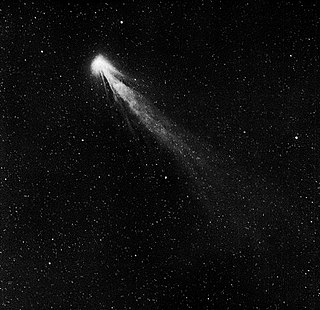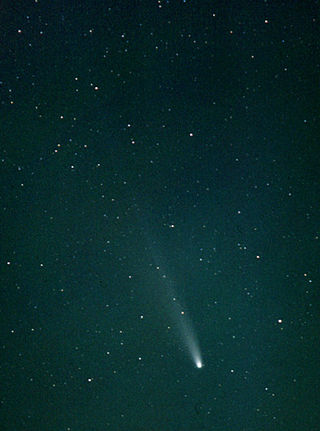
Comet Encke, or Encke's Comet, is a periodic comet that completes an orbit of the Sun once every 3.3 years. Encke was first recorded by Pierre Méchain on 17 January 1786, but it was not recognized as a periodic comet until 1819 when its orbit was computed by Johann Franz Encke. Like Halley's Comet, it is unusual in its being named after the calculator of its orbit rather than its discoverer. Like most comets, it has a very low albedo, reflecting only 4.6% of the light its nucleus receives, although comets generate a large coma and tail that can make them much more visible during their perihelion. The diameter of the nucleus of Encke's Comet is 4.8 km.

Comet Humason, formally designated C/1961 R1, was a non-periodic comet discovered by Milton L. Humason on September 1, 1961. Its perihelion was well beyond the orbit of Mars, at 2.133 AU. The outbound orbital period is about 2516 years. The diameter of its comet nucleus is estimated at 30−41 km.

Comet Machholz, formally designated C/2004 Q2, is a long-period comet discovered by Donald Machholz on August 27, 2004. It reached naked eye brightness in January 2005. Unusual for such a relatively bright comet, its perihelion was farther from the Sun than the Earth's orbit.

Comet Ikeya–Zhang is a comet discovered independently by two astronomers from Japan and China in 2002. It has by far the longest orbital period of the numbered periodic comets. It was last observed in October 2002 when it was about 3.3 AU (490 million km) from the Sun.

Comet Finlay is a periodic comet with an orbital period of 6 years discovered by William Henry Finlay on September 26, 1886. The next perihelion passage is July 13, 2021 when the comet will have a solar elongation of 54 degrees at approximately apparent magnitude 10. It last came to perihelion on December 27, 2014, at around magnitude 10. Of the numbered periodic comets, the orbit of 15P/Finlay has one of the smallest minimum orbit intersection distances with the orbit of Earth (E-MOID). In October 2060 the comet will pass about 5 million km from Earth.
Comet C/1861 G1 (Thatcher) is a long-period comet with roughly a 422-year orbit that is expected to return around 2283. It was discovered by A. E. Thatcher. It is responsible for the April Lyrid meteor shower. Carl Wilhelm Baeker also independently found this comet. The comet passed about 0.335 AU from the Earth on 5 May 1861 and last came to perihelion on 3 June 1861.
C/2007 W1 (Boattini) is a long-period comet discovered on 20 November 2007, by Andrea Boattini at the Mt. Lemmon Survey. At the peak the comet had an apparent magnitude around 5.
C/1992 J1 (Spacewatch) is a comet that was discovered 1 May 1992 by David Rabinowitz of the Spacewatch Project. This was the first comet to be discovered using an automated system.
C/2000 W1 (Utsunomiya–Jones) is a long-period comet from the Oort cloud discovered on November 18, 2000, by Syogo Utsunomiya and Albert F. A. L. Jones. The comet reached up to apparent magnitude 5.5, but was only 27 degrees from the Sun in mid-December 2000.
C/1999 F1 (Catalina) is one of the longest known long-period comets. It was discovered on March 23, 1999, by the Catalina Sky Survey. The current perihelion point is outside of the inner Solar System which helps reduce planetary perturbations to this outer Oort cloud object and keep the inbound and outbound orbital periods similar.
C/2001 OG108 (LONEOS) is a Halley-type comet with an orbital period of 48.51 years. It was discovered on 28 July 2001 by the LONEOS telescope at Lowell Observatory. Of the short-period comets with known diameters and perihelion inside the orbit of Earth, C/2001 OG108 is the second largest after Comet Swift–Tuttle.

C/1999 S4 (LINEAR) was a long-period comet discovered on September 27, 1999, by LINEAR.
75D/Kohoutek is a short-period comet discovered in February 1975, by Luboš Kohoutek. Even on the discovery plate the comet was only apparent magnitude 14. Assuming the comet has not disintegrated the 2020-2021 perihelion passage is only expected to peak around apparent magnitude 20.
In observational astronomy, the observation arc of a Solar System body is the time period between its earliest and latest observations, used for tracing the body's path. It is usually given in days or years. The term is mostly used in the discovery and tracking of asteroids and comets. Arc length has the greatest influence on the accuracy of an orbit. The number, spacing of intermediate observations, and timestamps have a lesser effect.

C/2015 ER61 (PanSTARRS) is a comet and inner Oort cloud object. When classified as a minor planet, it had the fourth-largest aphelion of any known minor planet in the Solar System, after 2005 VX3, 2012 DR30, and 2013 BL76. It additionally had the most eccentric orbit of any known minor planet, with its distance from the Sun varying by about 99.9% during the course of its orbit, followed by 2005 VX3 with an eccentricity of 0.9973. On 30 January 2016, it was classified as a comet when it was 5.7 AU from the Sun. It comes close to Jupiter, and a close approach in the past threw it on the distant orbit it is on now.
(457175) 2008 GO98, provisional designation 2008 GO98 with cometary number 362P, is a Jupiter family comet in a quasi-Hilda orbit within the outermost regions of the asteroid belt. It was discovered on 8 April 2008, by astronomers of the Spacewatch program at Kitt Peak National Observatory near Tucson, Arizona, in the United States. This presumably carbonaceous body has a diameter of approximately 15 kilometers (9 miles) and rotation period of 10.7 hours.

C/2017 U7 (PanSTARRS) is a hyperbolic comet, first observed on 29 October 2017 by astronomers of the Pan-STARRS facility at Haleakala Observatory, Hawaii, United States when the object was 7.8 AU (1.2 billion km) from the Sun. Despite being discovered only 10 days after interstellar asteroid 1I/'Oumuamua, it was not announced until March 2018 as its orbit is not strongly hyperbolic beyond most Oort Cloud comets. Based on the absolute magnitude of 10.6, it may measure tens of kilometers in diameter. As of August 2018, there is only 1 hyperbolic asteroid known, ʻOumuamua, but hundreds of hyperbolic comets are known.

C/2019 Y4 (ATLAS) was a comet with a near-parabolic orbit discovered by the ATLAS survey on December 28, 2019. Early predictions based on the brightening rate suggested that the comet could become as bright as magnitude 0 matching the brightness of Vega. It received widespread media coverage due to its dramatic increase in brightness and orbit similar to the Great Comet of 1844, but on March 22, 2020, the comet started disintegrating. Such fragmentation events are very common for Kreutz Sungrazers. The comet continues to fade and did not reach naked eye visibility. By mid-May, comet ATLAS appeared very diffuse even in a telescope. C/2019 Y4 (ATLAS) has not been seen since May 21, 2020.

C/2019 U6 (Lemmon), or Comet Lemmon is a long period comet with a near-parabolic orbit discovered by the Mount Lemmon Survey on October 31, 2019. It made its closest approach to the Sun on June 18, 2020. In June 2020 it was visible near the naked eye limit at an apparent magnitude of 6.0. It is the 3rd brightest naked eye comet of 2020 after C/2020 F3 (NEOWISE) and C/2020 F8 (SWAN). It remained visible near the naked eye limit in June.












